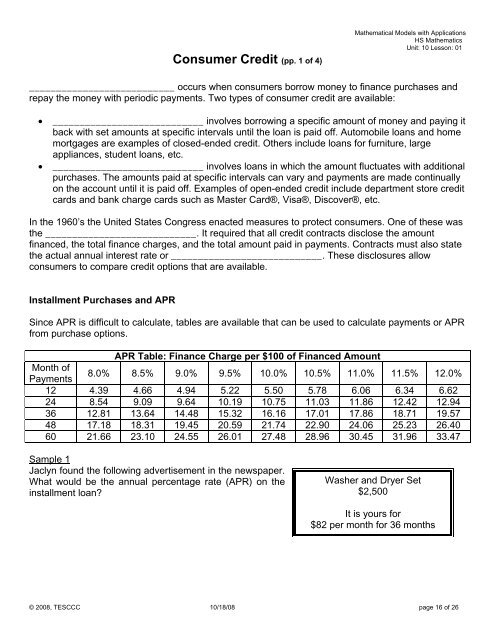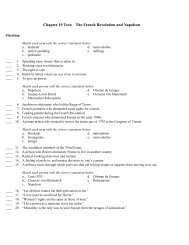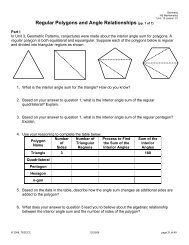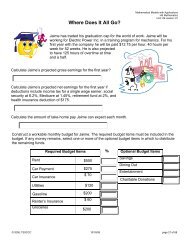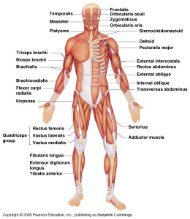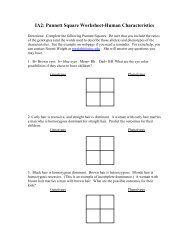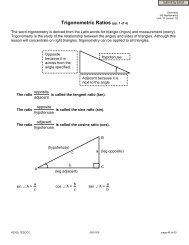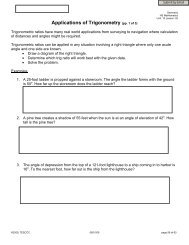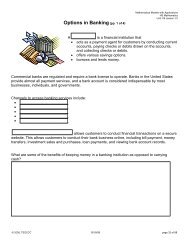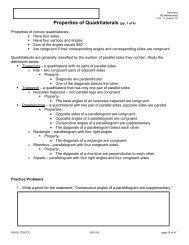Consumer Credit (pp. 1 of 4)
Consumer Credit (pp. 1 of 4)
Consumer Credit (pp. 1 of 4)
Create successful ePaper yourself
Turn your PDF publications into a flip-book with our unique Google optimized e-Paper software.
<strong>Consumer</strong> <strong>Credit</strong> (<strong>pp</strong>. 1 <strong>of</strong> 4)<br />
Mathematical Models with A<strong>pp</strong>lications<br />
HS Mathematics<br />
Unit: 10 Lesson: 01<br />
___________________________ occurs when consumers borrow money to finance purchases and<br />
repay the money with periodic payments. Two types <strong>of</strong> consumer credit are available:<br />
• ____________________________ involves borrowing a specific amount <strong>of</strong> money and paying it<br />
back with set amounts at specific intervals until the loan is paid <strong>of</strong>f. Automobile loans and home<br />
mortgages are examples <strong>of</strong> closed-ended credit. Others include loans for furniture, large<br />
a<strong>pp</strong>liances, student loans, etc.<br />
• ____________________________ involves loans in which the amount fluctuates with additional<br />
purchases. The amounts paid at specific intervals can vary and payments are made continually<br />
on the account until it is paid <strong>of</strong>f. Examples <strong>of</strong> open-ended credit include department store credit<br />
cards and bank charge cards such as Master Card®, Visa®, Discover®, etc.<br />
In the 1960’s the United States Congress enacted measures to protect consumers. One <strong>of</strong> these was<br />
the ____________________________. It required that all credit contracts disclose the amount<br />
financed, the total finance charges, and the total amount paid in payments. Contracts must also state<br />
the actual annual interest rate or ____________________________. These disclosures allow<br />
consumers to compare credit options that are available.<br />
Installment Purchases and APR<br />
Since APR is difficult to calculate, tables are available that can be used to calculate payments or APR<br />
from purchase options.<br />
APR Table: Finance Charge per $100 <strong>of</strong> Financed Amount<br />
Month <strong>of</strong><br />
Payments<br />
8.0% 8.5% 9.0% 9.5% 10.0% 10.5% 11.0% 11.5% 12.0%<br />
12 4.39 4.66 4.94 5.22 5.50 5.78 6.06 6.34 6.62<br />
24 8.54 9.09 9.64 10.19 10.75 11.03 11.86 12.42 12.94<br />
36 12.81 13.64 14.48 15.32 16.16 17.01 17.86 18.71 19.57<br />
48 17.18 18.31 19.45 20.59 21.74 22.90 24.06 25.23 26.40<br />
60 21.66 23.10 24.55 26.01 27.48 28.96 30.45 31.96 33.47<br />
Sample 1<br />
Jaclyn found the following advertisement in the newspaper.<br />
What would be the annual percentage rate (APR) on the<br />
installment loan?<br />
Washer and Dryer Set<br />
$2,500<br />
It is yours for<br />
$82 per month for 36 months<br />
© 2008, TESCCC 10/18/08 page 16 <strong>of</strong> 26
<strong>Consumer</strong> <strong>Credit</strong> (<strong>pp</strong>. 2 <strong>of</strong> 4)<br />
Mathematical Models with A<strong>pp</strong>lications<br />
HS Mathematics<br />
Unit: 10 Lesson: 01<br />
Sample 2<br />
Jaclyn found the same washer and dryer combination at another store for $1,995. This store will<br />
finance the set at 8.0% APR for 24 months. If Jaclyn pays $295 down, what will be her monthly<br />
payment?<br />
<strong>Credit</strong> and Charge Cards<br />
___________ are established when the cards are issued. Payments are determined by finding a<br />
percentage <strong>of</strong> the balance. Some bank cards have an annual fee. In order to save money when using<br />
credit cards, you should use cards with no annual fee and pay <strong>of</strong>f the balance each month. If the<br />
balance is not paid <strong>of</strong>f each month, the credit card company will charge interest on the balance. This<br />
is done one <strong>of</strong> two ways, interest on the unpaid balance or interest on the average daily balance.<br />
Interest on the average daily balance is most <strong>of</strong>ten used today.<br />
When calculating interest using the ____________ method, interest is calculated only on the unpaid<br />
balance and is not affected by payments or new purchases.<br />
Sample 3<br />
Selena received her monthly statement for Cavazos Clothing where she has a charge card. Her<br />
previous balance was $630. She made a payment that was 10% <strong>of</strong> the unpaid balance and then<br />
charged an additional $123.53 for a pair <strong>of</strong> shoes. The charge card has an annual interest rate <strong>of</strong><br />
16%. Determine the new balance on Selena’s account.<br />
© 2008, TESCCC 10/18/08 page 17 <strong>of</strong> 26
<strong>Consumer</strong> <strong>Credit</strong> (<strong>pp</strong>. 3 <strong>of</strong> 4)<br />
Mathematical Models with A<strong>pp</strong>lications<br />
HS Mathematics<br />
Unit: 10 Lesson: 01<br />
When calculating interest using ________________ method, interest is calculated not only on the<br />
unpaid balance but also on payments or new purchases made that month. (The sample problem for<br />
the unpaid balance interest will be used in order to make comparisons.)<br />
Sample 4<br />
Selena received her monthly statement for Cavazos Clothing where she has a charge card. Her<br />
previous balance was $630. She made a payment that was 10% <strong>of</strong> the unpaid balance and then<br />
charged an additional $123.53 for a pair <strong>of</strong> shoes. The charge card has an annual interest rate <strong>of</strong><br />
16%. Determine the new balance on Selena’s account.<br />
April 3 billing date<br />
April 12 payment<br />
April 20 shoe purchase<br />
May 3 next billing date<br />
Date Transaction Balance<br />
Date Balance Due<br />
Total<br />
Days Until<br />
Balance Changed<br />
Balance Due<br />
x<br />
Number <strong>of</strong> Days<br />
How do the two methods compare? Which method a<strong>pp</strong>ears better for the credit company?<br />
© 2008, TESCCC 10/18/08 page 18 <strong>of</strong> 26
Practice Problems<br />
<strong>Consumer</strong> <strong>Credit</strong> (<strong>pp</strong>. 4 <strong>of</strong> 4)<br />
Mathematical Models with A<strong>pp</strong>lications<br />
HS Mathematics<br />
Unit: 10 Lesson: 01<br />
1. Cesar purchased a $4,500 sound system for his new entertainment center. He paid $500 down<br />
and financed the remainder for 48 months. His monthly payments were set at $102.41. Find<br />
the finance charge and the APR.<br />
2. Sassy Sails is featuring a special financing plan this month with a 9.0% APR for 36 months. If<br />
Jules purchases a sail board for $1,350 with no money down, what will be his monthly<br />
payments?<br />
3. The table below is a summary <strong>of</strong> the transactions for Alice’s credit card. Use the unpaid<br />
monthly balance method to fill in the table. The card is at a 15% annual interest rate. Assume<br />
that each month she pays 12% <strong>of</strong> her unpaid balance.<br />
Month<br />
Unpaid balance<br />
at beginning <strong>of</strong><br />
month<br />
Finance charge Purchases Payments<br />
August $432.20 $42.50<br />
September $245.00<br />
October $124.60<br />
November<br />
4. Using the information below, calculate the new credit card balance on September 1 by the<br />
average daily balance method. Assume an annual percentage rate <strong>of</strong> 12.5%.<br />
Billing date 8/1 Balance $132.10<br />
8/10 Condo rental $750.00<br />
8/13 Payment $500.00<br />
Date Balance Due<br />
Total<br />
8/20 School clothes $175.65<br />
Days Until<br />
Balance Changed<br />
Balance Due<br />
x<br />
Number <strong>of</strong> Days<br />
© 2008, TESCCC 10/18/08 page 19 <strong>of</strong> 26


